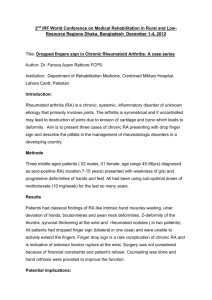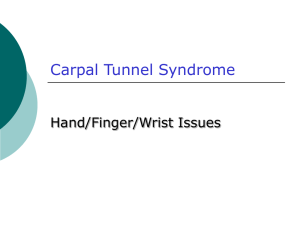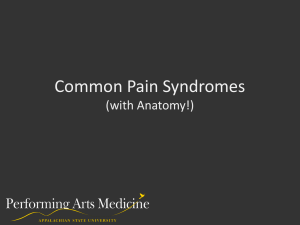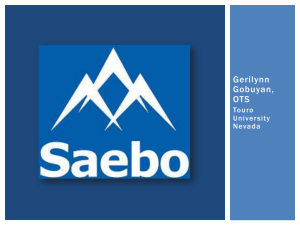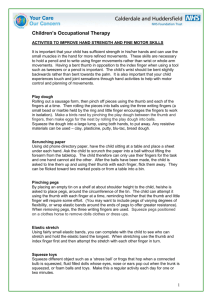2479-LDG-E HAND, WRIST AND FINGER SAFETY IN
advertisement
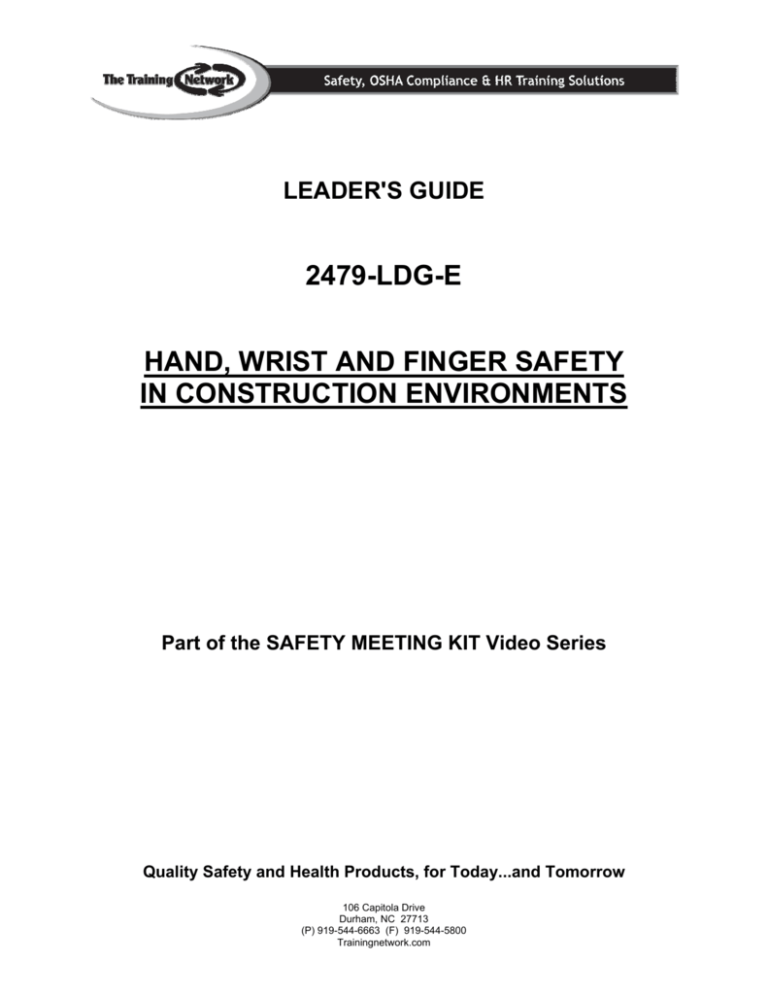
LEADER'S GUIDE 2479-LDG-E HAND, WRIST AND FINGER SAFETY IN CONSTRUCTION ENVIRONMENTS Part of the SAFETY MEETING KIT Video Series Quality Safety and Health Products, for Today...and Tomorrow 106 Capitola Drive Durham, NC 27713 (P) 919-544-6663 (F) 919-544-5800 Trainingnetwork.com THE SAFETY MEETING KIT VIDEO SERIES This education program is part of the Safety Meeting Kit Video Series. The programs in this series have been created to provide employees with good, basic information on everyday safety and health topics. This series includes programs on the following topics: - - - Accident Investigation The ANSI MSDS Back Safety Compressed Gas Cylinders Computer Workstation Safety Conflict Resolution (Industrial and Office versions) Crane Safety (Industrial and Construction versions) Driving Safety Dealing with Drug and Alcohol Abuse (Employees and Managers/Supervisors versions) Electrical Safety Eye Safety (Industrial and Construction versions) Ergonomics (Industrial and Office versions) Fall Protection Fire Extinguishers Fire Prevention (Healthcare, Industrial and Office versions) First Aid (Industrial and Construction versions) Hand and Power Tool Safety (Industrial and Construction versions) Hand, Wrist and Finger Safety (Industrial and Construction) - Hazardous Materials Labels - Hazardous Spill Cleanup - Heat Stress (Industrial and Construction versions) - Ladder Safety (Industrial and Construction versions) - Machine Guard Safety - Materials Handling Safety - Office Safety - Rigging Safety (Industrial and Construction versions) - Safety Audits - Safety Housekeeping and Accident Prevention - Safety Orientation - Safety Showers and Eye Washes - Sexual Harassment (Employees & Managers/ Supervisors versions) - Sexual Harassment Investigations - Slips, Trips and Falls - Welding Safety (Industrial and Construction versions) - Wellness and Fitness - Winter Safety - Workplace Harassment (Industrial and Office versions) - Workplace Stress - Workplace Violence 106 Capitola Drive Durham, NC 27713 (P) 919-544-6663 (F) 919-544-5800 Trainingnetwork.com Other products in the Safety Meeting Kit line include employee booklets and posters which have been designed specifically to be used with the programs. By combining these three products you have all of the materials you need to promote and conduct a complete safety meeting (for information on booklets and posters contact your local distributor). 106 Capitola Drive Durham, NC 27713 (P) 919-544-6663 (F) 919-544-5800 Trainingnetwork.com WARRANTY/DISCLAIMER "This program has been created to assist companies that are endeavoring to educate their employees regarding good safety and health practices. The information contained in this program is the information available to the producers of the program at the time of its production. All information in this program should be reviewed for accuracy and appropriateness by companies using the program to assure that it conforms to their situation and recommended procedures, as well as to any state, federal or other laws, standards and regulations governing their operations. There is no warranty, expressed or implied, that the information in this program is accurate or appropriate for any particular company's environment." Copyright 2009, The MARCOM Group, Ltd. 106 Capitola Drive Durham, NC 27713 (P) 919-544-6663 (F) 919-544-5800 Trainingnetwork.com TABLE OF CONTENTS 1 INTRODUCTION TO THE PROGRAM — Structure and organization — Background — Objectives — Reviewing the program 2 PREPARING FOR THE PRESENTATION — Structuring the presentation — Setting up the class and classroom 3 CONDUCTING THE SESSION — The initial steps — Showing the program — Using the program for Tailgate Meetings and Toolbox Talks — Conducting the discussion — Concluding the presentation — Wrapping up the paperwork 4 OUTLINE OF MAJOR POINTS IN THE PROGRAM 5 ACCOMPANYING MATERIALS — Scheduling and Attendance Form — Quiz — Training Certificate — Employee Training Log 106 Capitola Drive Durham, NC 27713 (P) 919-544-6663 (F) 919-544-5800 Trainingnetwork.com INTRODUCTION TO THE PROGRAM Structure and Organization Information in this program is presented in a definite order, so that employees will see the relationships between the various groups of information and can retain them more easily. The sections included in the program are: • The hand… and how it works. • Preparing for the job. • Available personal protective equipment. • Fit and care of personal protective equipment. • Ergonomic hazards. Each of the sections covers important information in one topic area, providing employees with the basis for understanding the concepts of hand, wrist and finger safety. Background Our hands, wrists and fingers are valuable tools… the most valuable we'll ever own. Whether we're completing a project at work or playing catch with the kids, our hands are involved in just about everything we do. In fact, we use our hands and wrists so much that they are exposed to a multitude of hazards. Throughout the day our hands and wrists can encounter hazards such as: • Machines with heavy or fast moving parts that can pinch or grab. • Sharp tools that can cut or puncture. • Corrosive materials that can damage the skin. 106 Capitola Drive Durham, NC 27713 (P) 919-544-6663 (F) 919-544-5800 Trainingnetwork.com • Stresses and strains from working in awkward positions. If these types of hazards go unchecked, they can cause real problems. Fortunately, there are a number of ways that we can protect and care for our hands and wrists. Objectives To help remind employees of hand, wrist and finger problems that can occur, as well as what can be done to address these problems, this education and training program is designed to present the fundamentals of good hand, wrist and finger practices. Upon completion of the program, employees should: • Understand the physiology of their hands, wrists and fingers, and how the various parts work together. • Recognize situations that are potentially hazardous to the hands, wrists and fingers. • Understand how certain types of movements can cause ergonomic problems. • Recognize work situations in their own jobs that might have the potential for hand, wrist and finger injuries. • Be able to select tools and equipment that will minimize the potential for hand, wrist and finger injuries. • Know how to choose appropriate personal protective equipment for their hands, wrists and fingers. 106 Capitola Drive Durham, NC 27713 (P) 919-544-6663 (F) 919-544-5800 Trainingnetwork.com Reviewing the Program As with any educational program, the presenter should go through the entire program at least once to become familiar with the content and make sure the program is consistent with company policy and directives. An Outline of Major Program Points section is included in this Leader's Guide to help with this task and for general reference. As part of this review process, you should determine how you, as the presenter, will conduct your session. The use of materials such as handouts, charts, etc., that may be available to you needs to be well thought out and integrated into the overall program presentation. 106 Capitola Drive Durham, NC 27713 (P) 919-544-6663 (F) 919-544-5800 Trainingnetwork.com PREPARING FOR THE PRESENTATION Structuring the Presentation In conducting this education session, you should proceed with a friendly and helpful attitude. Remember that the trainees are looking to your experience and knowledge to help them relate to the situations shown in the program. It is important to let the trainees interact with you and each other during the training session. Stimulating conversation within the group is one of the best things you, as the presenter of the program, can do to help everyone get as much as possible from the session. Be alert for comments that could help in this area in future sessions and make note of them. As the presenter, you also should: • Keep the session related to the topic of hand, wrist and finger safety in construction environments. • Relate discussions to how hand, wrist and finger safety considerations can affect the work of class participants. • Prevent any one person or small group of employees in the session from doing all the talking. • Get everyone involved. Ask questions of those who don't participate voluntarily. • Clarify comments by relating them to the key points in the program. Use the Outline of Major Program Points section included in the guide, as well as the information included in the quiz, as the basis for answering any questions. If you don't know the answer, say so. Tragic results may occur should you provide incorrect or inaccurate information. Remember, this is a positive program on hand, wrist and finger safety. Make sure your attitude and words reflect this and that the emphasis is always on providing the information needed by the attendees to improve their ability to recognize situations that can give rise to hand, wrist and finger safety problems, and know what they can do to prevent them. 106 Capitola Drive Durham, NC 27713 (P) 919-544-6663 (F) 919-544-5800 Trainingnetwork.com Setting Up the Class and Classroom There are a number of things that must be done to set up the class as well as the classroom. If you are using the program for a Tailgate Meeting or Toolbox Talk some of these things won't apply, but many of them will. So you will still need to run through this checklist prior to your training session. They include: - Scheduling and Notification — Use the enclosed form to schedule employees into the session. — Make sure that the session is scheduled so that it fits into your attendees' work day. — Send out notification of the session well in advance, to give people enough time to incorporate it into their schedule for that day. — If possible, post a notification on bulletin boards in the affected employees' areas. - The Classroom — Schedule the room well in advance. — Make sure the room can accommodate the expected number of attendees. — Check it again on the day of the program to make sure there is no conflict. — Make sure the room can be darkened, and won't create a glare on the television screen. — Locate the light controls and test them. — Make sure the power for the videotape or DVD player you are using operates separately from the room light. — See if you can control the room temperature. — Know where the closest restrooms are. — Assure that the room is free from distracting noises. — Make sure emergency exits are marked and known to the attendees. - Seating — Make sure everyone can see the screen from their seat. — Make sure everyone can hear the videotape/DVD and you (when you speak). 106 Capitola Drive Durham, NC 27713 (P) 919-544-6663 (F) 919-544-5800 Trainingnetwork.com — Check to see that seating is such that writing can be done easily. — Make sure the seating arrangement allows eye contact amongst attendees and between yourself and attendees. - Equipment and Materials — Make sure the videotape or DVD player monitor, and all appropriate cables and extension cords are available. — Make sure a stand or table is available and is of appropriate height for all attendees to easily see the monitor. — If you plan on using a chartpad, blackboard, or other writing board, make sure it is available, easy to see, and you have the proper writing implements. — Make sure you have 6" x 8" index cards or other materials to be used as name tents for attendees. — Make sure you have made up a sufficient number of copies of the quiz, as well as any other handouts you are using. - Final Check — Make sure equipment is in the room prior to the scheduled session. — Check to see that the room is set up properly. — Check equipment prior to the presentation to assure that it works. — Make sure extension cords, etc. are taped down, if need be, to avoid tripping. — If you are using the videotape version of the program, run the leader up to the point where the program begins. 106 Capitola Drive Durham, NC 27713 (P) 919-544-6663 (F) 919-544-5800 Trainingnetwork.com CONDUCTING THE SESSION The Initial Steps In conducting the session remember the positive nature of this presentation. Everyone is attending in order to learn more about how to improve their hand, wrist and finger safety practices and as a result work more safely and productively. Initially, you need to: • Introduce yourself as the session leader. • State the title of the program, Hand, Wrist and Finger Safety In Construction Environments, and the purpose of the session (to learn about how to guard against hand, wrist and finger injuries). • Inform the attendees when there will be breaks (if you plan them) the location of exits and restrooms and if water, coffee, or other refreshments will be available. • Make sure all of the attendees have signed in on your scheduling and attendance sheet. Remember, it is very important to document peoples' attendance at the session. Once this housekeeping is done, it is time to move to the meat of the session. First, the attendees need to be informed about the objectives of the session (this is where you can use a flip chart or board to list the objectives, which should be done prior to the class starting). This listing should be preceded with some introductory remarks. Your own words are always best, but the remarks should include information such as the following paragraphs: "Today we are going to talk about hand, wrist and finger safety. Our hands are naturally involved in virtually everything we do. As a result, we don't often think about having to safeguard them. Yet there are more accidents and injuries involving hands, wrists and fingers than any other type of injury... both at work and at home! These injuries account for thousands of hours of lost time and millions of dollars of workers compensation and medical costs each year." 106 Capitola Drive Durham, NC 27713 (P) 919-544-6663 (F) 919-544-5800 Trainingnetwork.com "We need to remember that there are many situations that we encounter which have the potential to cause hand, wrist and finger problems. Often our jobs involve a number of different work environments, using different materials and tools. And we are frequently lifting awkward and heavy objects. All of these things have the potential to cause hand, wrist or finger injuries." "We can protect against these hazards and resulting accidents or injuries by making sure that we follow appropriate safety procedures in the things that we do. We need to know what techniques we should use when lifting or moving objects that could pinch or crush our fingers and hands. We need to know what types of motions have the potential to cause ergonomic problems... and what we can do to avoid them." "We also need to recognize what tools we should use that will limit exposure of our hands, wrists or fingers to potential injury, as well as what safeguards we should take in working with the equipment that we use every day. We should also be knowledgeable about the various types of personal protective equipment, especially gloves, we should use as we go about our jobs." "The program we are going to watch today will give us some good information on the types of hand, wrist and finger problems that can occur in our jobs, and what steps we should take to avoid them. We will also learn what we can do to protect ourselves from the problems we encounter. To make this the most productive session possible, we need to look at what we want to accomplish here today (verbally reference the Objectives list from the first section of this guide, or point to the blackboard or chart where you have written them down)." Once the objectives have been provided, you are ready to show the program. However, you do need to let the attendees know that they will be taking a quiz at the end of the session (if you are using it). It needs to be emphasized that they are not being graded, but that the quiz is being used to see if the session is effectively transmitting information to them in a way they will remember. 106 Capitola Drive Durham, NC 27713 (P) 919-544-6663 (F) 919-544-5800 Trainingnetwork.com Showing the Program At this point, you need to introduce the title of the videotape program once again, Hand, Wrist and Finger Safety In Construction Environments, darken the lights if necessary, and begin the showing of the videotape. If you are using the DVD version of the course you have several options as to how you can move through the program and what employees see. The DVD menu has two selection bars: • Play. • Contact Us. To just play the program from beginning to end, select Play. If you would like information on other programs and products that are available from Training Network you can select Contact Us for information about how to contact us. Using the Program for Tailgate Meetings and Toolbox Talks The DVD version of the program has been designed specifically to facilitate Tailgate Meetings and Toolbox Talks. The information in the DVD has been divided into 2-3 minute chapters on different issues involved with hand, wrist and finger safety. Each chapter forms the basis for a focused 10-15 minute session on an important aspect of that topic (chapters can be directly selected from the DVD menu). 106 Capitola Drive Durham, NC 27713 (P) 919-544-6663 (F) 919-544-5800 Trainingnetwork.com Conducting the Discussion After the program or chapter has been shown, it is time for the group discussion on the information contained in the session. Care must be taken to make sure that the discussion is kept to the general topic of hand, wrist and finger safety. There are several ways to conduct this discussion. These include: • Calling for questions from the attendees and using these questions as the basis for the discussion. • Leading the discussion through the points covered in the program using statements such as: — "One of the sections that we saw in the program was about recognizing common hand, wrist and finger hazards. What are some of the hand, wrist and finger hazards that we know exist in our jobs?" — "We saw several interesting things about the power and precision grips. Who can review the differences between these two grips and tell us when we should use each one?" You should use the discussion format that you are most comfortable with. The Outline of Major Program Points section in this guide, and the questions and answers in the master copies of the quiz can be very useful as a basis for discussion. Remember, you have allocated a limited amount of time in which this discussion can take place. It is important to blend the attendees' questions and areas of obvious interest with the objective of trying to touch on each major area within the session in the discussion. By touching on each area, the attendees are much more likely to retain the information presented in the session. 106 Capitola Drive Durham, NC 27713 (P) 919-544-6663 (F) 919-544-5800 Trainingnetwork.com Concluding the Presentation Once discussion has concluded, whether naturally or you have had to bring the discussion to a close in order to complete the session within the time allowed, it is time to give the quiz (if you are using it). Again, remind the attendees that the quiz is only meant to help determine how effective the presentation of the information is, and that they will not be graded on it. Let them know that they have approximately five minutes to complete the quiz. At the end of the five minute period, remind the attendees to date and sign their quizzes, and then collect them. The attendees should be thanked for attending the session and reminded of any other sessions in the educational program that they may be attending. They can then be dismissed to return to their normal activities. *(An alternative to this approach is to give the quiz immediately after showing the program, then use a review of the quiz as a basis for your group discussion.) Wrapping Up the Paperwork Before much time has passed, and the subject matter is fresh in your mind, several areas of paperwork must be completed. First, check to make sure that all attendees signed the scheduling and attendance form. Next, make sure that you have a quiz from every attendee, dated and signed. Also, depending upon what you have decided to do, a copy of the attendance sheet and the quiz for each attendee should be either filed in your files, or turned over to the attendee's department manager (or the personnel office) so that this paperwork can be included in their personnel file. The attendees' training logs should also be updated, and each attendee should be given a filled out and signed training certificate, signifying that they have successfully completed the course. 106 Capitola Drive Durham, NC 27713 (P) 919-544-6663 (F) 919-544-5800 Trainingnetwork.com OUTLINE OF MAJOR PROGRAM POINTS The following outline summarizes the major points of information presented in the program. The outline can be used to review the program before conducting a classroom session, as well as in preparing to lead a class discussion about the program. • Our hands, wrists and fingers are valuable tools, the most valuable we'll ever own. — Whether we're completing a project at work or playing catch with the kids, our hands are involved in just about everything we do. • In fact, we use our hands and wrists so much that they are exposed to a multitude of hazards. — Fortunately, there are a number of ways that we can protect and care for them. • Throughout the day our hands and wrists can encounter hazards such as: — Machines with heavy or fast moving parts that can pinch or grab. — Sharp tools that can cut or puncture. — Corrosive materials that can damage the skin. • If these types of hazards go unchecked, they can cause real problems. • Each year thousands of people suffer unnecessary injuries to their hands, wrists and fingers. — The initial pain caused by these injuries is often just the beginning of a long ordeal. — Treatment can be followed by a prolonged recovery period, with many hours of physical rehabilitation. — And after recovering from an accident, we often have to work harder to make up for production time that was lost while we were away. 106 Capitola Drive Durham, NC 27713 (P) 919-544-6663 (F) 919-544-5800 Trainingnetwork.com • Preventing these injuries can be easy. — All you have to do is make an effort. • First, let's take a look at how the hand works. — Our hands are made up of a complex system of bones, soft tissue and skin, which give them strength and flexibility. • Each hand has 27 bones that form the wrist, palm and fingers. — The soft tissue, muscles, ligaments, tendons, and nerves, bind the bones together and give the hand power, the ability to move and sensation. — Skin provides the hand with a protective cover that holds this well designed system together. • The way the human hand is constructed allows us to work very efficiently. — The system of nerves in the hand is so refined that we're often able to perform tasks by touch alone, without relying on our eyesight. • Our hands also easily adjust into different positions, so that we can perform our work most effectively. — We can form a powerful grip by curling our fingers and thumb around an object. — Grasping an object with the entire hand distributes the weight of the object evenly over the muscles and tendons, which also allows the forearms to help with the load. • With tasks that demand a delicate touch, the precision grip is what is needed. Here, objects are surrounded by bringing the thumb, middle and index fingers together. — The precision grip works well for close-up tasks like centering a nail or writing with a pen. — But avoid using this grip on heavy objects. — Instead, choose a good power grip, which will place less stress on your hand and wrist. 106 Capitola Drive Durham, NC 27713 (P) 919-544-6663 (F) 919-544-5800 Trainingnetwork.com • The power and precision grips are just two of the various grips that we use to get our work done. — The ability our hands have to adapt to different work situations is one of the things that make them so useful! • You can take care of your hands by paying attention to the basics and preparing for the job you'll be doing. • You need to develop a Safety First attitude, because the best way to stay safe is to prevent accidents from happening in the first place. — You should be aware of the hazards that exist in your environment. — Become familiar with the equipment that you use. — Keep track of the work that's going on around you. • Pay attention to your state of mind as well. — Concentrate on what you are doing. — Make sure to control your emotions when things aren't going the way you'd like them to. • Stay clear of distractions and learn to pace yourself. — It only takes a fraction of a second for an accident to occur, so be careful. • There are a lot of potential hazards in our work environments. — High-speed cutting tools, heavy machinery, and sharp edges are just a few of the things that we can encounter. • Because of their moving parts, many tools and machines can be dangerous. — If we're not careful, our hands can be cut, pinched, even crushed. — So make sure that all safety shields and guards are in place before you start work. 106 Capitola Drive Durham, NC 27713 (P) 919-544-6663 (F) 919-544-5800 Trainingnetwork.com • Not knowing how to use a machine or tool can lead to an accident too. — So take the time to become familiar with the equipment that you are working with. — Follow proper procedures for operating and maintaining it — Don't take short cuts. • Don't wear loose clothing that could get caught up in moving parts and pull your hands in with it. • Use common sense when you're working. — Be alert for the unexpected, think ahead and keep track of what your hands and fingers are doing. — Take the time to be safe! • When you are working with tools, be careful of handles that pinch your hand. — They can lead to injuries to your nerves, tendons and blood vessels. • Avoid handles with sharp edges and finger grooves. — Protect yourself by choosing tool handles that are smooth or padded. — They can be more comfortable, too! • Handles should be shaped or positioned so that your wrist can be kept straight when you're using them. — They should be long enough to extend across the palm, to avoid pinching nerves within the palm itself. • Trigger switches on power tools should be situated so that you use your middle finger or thumb to press them, instead of your index finger. — This allows the index finger to help balance the tool, without the additional stress of pressing the trigger. 106 Capitola Drive Durham, NC 27713 (P) 919-544-6663 (F) 919-544-5800 Trainingnetwork.com • Be careful with tools that cause vibration. — The combination of rapid movement and the way a tool is held can hurt circulation, or pinch nerves and tendons in your hand. — Vibration-absorbing gloves can help to protect you in these situations. • Even when you've selected the right tools, and are paying attention, things can go wrong. — So it's best to use PPE to ensure your safety. — Gloves are the most basic piece of protective equipment for the hand. — It's important to select gloves that provide the best protection from the hazards that you're working with. • Light outside work can often mean scratches, blisters and even poison ivy. — You can protect yourself from these hazards with a pair of simple cloth gloves. • Work involving rough surfaces, splinters and sparks can also lead to injuries. — Heavy-duty leather gloves will shield your hands from nicks and minor burns, and protect against bruising. • Operations involving sharp-edged tools, such as knives, can mean painful cuts and scratches. — In these situations, cut-resistant gloves made of metal mesh or similar materials are what you should wear. • Intense heat and flames can both burn your hands. — Heat-resistant gloves made of aluminized fabric or other special materials will let you work safely near high temperatures. 106 Capitola Drive Durham, NC 27713 (P) 919-544-6663 (F) 919-544-5800 Trainingnetwork.com • Contact with corrosive substances such as petroleum products, organic liquids or lyes can also damage the skin. — Here, you should protect yourself with gloves made of rubber, vinyl or neoprene. • Gloves do a good job with most hazards, but in some circumstances you'll need extra protection from minor irritants that might sneak through. — Special barrier creams cover the skin with another, invisible protective coating. — To get their full effect, barrier creams should only be applied to clean skin, and should be reapplied often. • Some jobs require protection that is even more specialized. — To guard against heat and splintery or abrasive materials, hand pads or guards will help keep your hands safe. • To protect against pinching hazards, use finger guards made of fabric or metal. • Remember, no single type of PPE will protect you in every situation. — So talk to your supervisor to determine what is right for you. • Choosing the right type of protective gear is just the start. — Other factors, like the correct fit and the care of your PPE, are also important. • Make sure your gloves are long enough to keep hazards from sneaking under them. — Trapped materials can become irritating and cause cuts and scratches. • Be sure to get a proper fit. — If gloves are too large for your hands, they will feel clumsy and may get caught in machinery. 106 Capitola Drive Durham, NC 27713 (P) 919-544-6663 (F) 919-544-5800 Trainingnetwork.com — If they're too small, your hands can tire quickly. — Gloves that are too tight can also wear out prematurely, increasing the chance of an accident. • Remember to inspect and test your gloves and other protective equipment before each use. — Look for rips and other defects. — Exchange or repair anything that is damaged. • Wash your PPE regularly, especially after exposure contaminants. — But keep it separate from your family's wash. — Your PPE may contain chemical residue that could damage clothing. to • Be sure to follow recommended storage procedures for your equipment. — Keep rubber and plastic gloves away from heat and sunlight. • It's also a good idea to keep spare gloves on hand, in case you forget your regular pair. • In addition to the external hazards caused by machinery and tools, we need to be aware of internal hazards, those ergonomic problems that can physically occur within the hand itself. — Your muscles, ligaments and tendons can all be stressed by performing repetitive motions. — Many jobs require you to do the same things over and over again. — That means making the same stressful movements with your hands and fingers for long periods of time. • Occasional or short-term exposure to these hazards shouldn't cause problems. — But long-term stresses over months and years can result in significant injuries. 106 Capitola Drive Durham, NC 27713 (P) 919-544-6663 (F) 919-544-5800 Trainingnetwork.com • We can reduce the risk of developing these types of problems by: — Alternating our work. — Varying the motions we make. — Cutting down on unnecessary movement. • As we have seen, we use our hands in a wide variety of ways. — And there are just as many ways to protect and take care of them. * * * SUMMARY * * * • Be aware of the hazards in your environment. • Learn how to work safely with the machines and equipment that you use. • Select tools that minimize stress and other hazards. • Use gloves and other protective equipment when needed. • Avoid repetitive motions that can lead to ergonomic problems. • Your hands do a lot of work for you! You need to keep them safe, so they continue to be your number one tool! 106 Capitola Drive Durham, NC 27713 (P) 919-544-6663 (F) 919-544-5800 Trainingnetwork.com ACCOMPANYING MATERIALS In order to assist you in conducting your session on hand, wrist and finger safety, we have provided some materials that can be used with this program. These materials have been furnished in master form. This will enable you to make as many copies of these forms as you need. If you have colored paper available to you, it is often useful to put each form on a different color. This enables you to easily differentiate between the materials. The materials enclosed with this guide include: Scheduling and Attendance Form This form is provided so you can easily schedule your attendees into each session of the program. It is important that you have each attendee sign in on the appropriate form, documenting their attendance at the session. Typically, a copy of this attendance/sign-in form is filed in the employee's personnel file. Quiz The quiz is normally given after viewing the program. However, if you want an indication of the increase in the attendees' knowledge of hand, wrist and finger safety, you can give the quiz both before and after the videotape is shown. You can also use the quiz as the basis for class discussion. If you have decided to give the quiz both before and after the attendees view the program, it is often interesting to have the attendees compare their before and after answers as part of the session. Typically, the quiz is filed in the employee's personnel file. 106 Capitola Drive Durham, NC 27713 (P) 919-544-6663 (F) 919-544-5800 Trainingnetwork.com Training Certificate This form allows you to give each employee their own certificate of completion showing that they have attended the course and taken the quiz. Space is provided to insert the employee's name, the course instructor and the date of completion. Employee Training Log This log helps you to keep track of when each employee has taken the course, as well as associated courses/training. Space is provided to list pertinent data about the employee, as well as information such as the date the course was taken, and the instructor conducting the course. A copy of this form should be kept in each employee's training or personnel file. 106 Capitola Drive Durham, NC 27713 (P) 919-544-6663 (F) 919-544-5800 Trainingnetwork.com SCHEDULING AND ATTENDANCE FORM HAND, WRIST AND FINGER SAFETY IN CONSTRUCTION ENVIRONMENTS TRAINING SESSION SCHEDULE ATTENDEE DATE TIME 106 Capitola Drive Durham, NC 27713 (P) 919-544-6663 (F) 919-544-5800 Trainingnetwork.com SIGNATURE QUIZ HAND, WRIST AND FINGER SAFETY IN CONSTRUCTION ENVIRONMENTS Name: Date: 1. The hand and wrist is a complex system. How many bones do they contain? 17. 27. 47. 2. True or False... Leather gloves are good protection against corrosive substances? True False 3. True or False... Barrier creams provide good protection against heat and hot surfaces? True False 4. True or False... While gloves that are too large can be hazardous, gloves that are too small don't really cause safety problems? True False 5. There are two major grips that we use when we work with our hands. What are they called? Precision grip. Open grip. Power grip. 6. True or False... The neutral position for the hand and wrist is one in which the wrist is bent at a 45o angle? True False 7. Which finger will a well designed power tool not use to activate the tool's trigger switch? Middle finger. Index finger. Thumb. 106 Capitola Drive Durham, NC 27713 (P) 919-544-6663 (F) 919-544-5800 Trainingnetwork.com QUIZ HAND, WRIST AND FINGER SAFETY IN CONSTRUCTION ENVIRONMENTS PRESENTER'S COPY WITH ANSWERS 1. The hand and wrist is a complex system. How many bones do they contain? 17. X 27. 47. 2. True or False... Leather gloves are good protection against corrosive substances? True X False 3. True or False... Barrier creams provide good protection against heat and hot surfaces? True X False 4. True or False... While gloves that are too large can be hazardous, gloves that are too small don't really cause safety problems? True X False 5. There are two major grips that we use when we work with our hands. What are they called? X Precision grip. Open grip. X Power grip. 6. True or False... The neutral position for the hand and wrist is one in which the wrist is bent at a 45o angle? True X False 7. Which finger will a well designed power tool not use to activate the tool's trigger switch? Middle finger. X Index finger. Thumb. 106 Capitola Drive Durham, NC 27713 (P) 919-544-6663 (F) 919-544-5800 Trainingnetwork.com EMPLOYEE TRAINING LOG HAND, WRIST AND FINGER SAFETY IN CONSTRUCTION ENVIRONMENTS DATE Employee: Employee #: Department: Date of Next Required Training: TYPE OF TRAINING OR COURSE DESCRIPTION LOCATION OF COURSE MATERIALS Social Security #: INSTRUCTOR'S NAME AND ADDRESS/DEPARTMENT 106 Capitola Drive Durham, NC 27713 (P) 919-544-6663 (F) 919-544-5800 Trainingnetwork.com CERTIFICATION OF TRAINING AND TESTING (Instructor's Signature) TRAINING CERTIFICATE This is to certify that _____________________________________ has (employee name) completed the course Hand, Wrist and Finger Safety in Construction Environments and has been tested on the contents of the course, as required. This training, as well as the associated testing was conducted by ___________________________ and was completed on _________. (course instructor) (date) _____________________________ ____________ (date) (course instructor) 106 Capitola Drive Durham, NC 27713 (P) 919-544-6663 (F) 919-544-5800 Trainingnetwork.com



